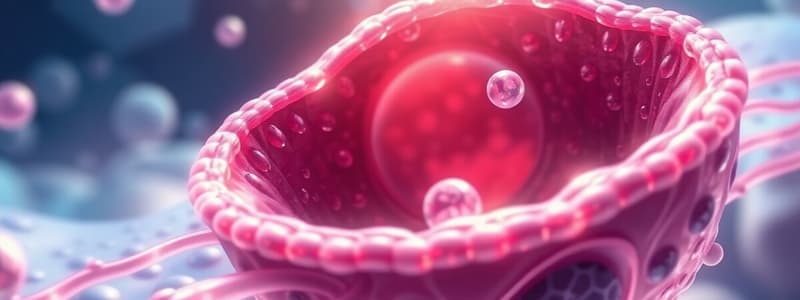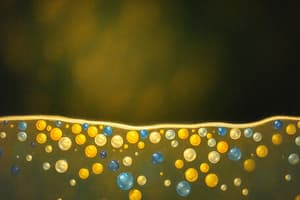Podcast
Questions and Answers
Which of the following is NOT a method by which substances can move across the cell membrane?
Which of the following is NOT a method by which substances can move across the cell membrane?
- Translation (correct)
- Active Transport
- Osmosis
- Diffusion
Passive transport requires the cell to expend energy to move substances across the membrane.
Passive transport requires the cell to expend energy to move substances across the membrane.
False (B)
What is the term for the pressure generated by water moving across a membrane?
What is the term for the pressure generated by water moving across a membrane?
osmotic pressure
The movement of molecules from an area of higher concentration to an area of lower concentration is known as ________.
The movement of molecules from an area of higher concentration to an area of lower concentration is known as ________.
Match each transport process with its description:
Match each transport process with its description:
Which type of molecule would most easily diffuse across a cell membrane?
Which type of molecule would most easily diffuse across a cell membrane?
The rate of diffusion decreases with an increase in temperature.
The rate of diffusion decreases with an increase in temperature.
What are the protein channels used in osmosis called?
What are the protein channels used in osmosis called?
__________ diffusion requires the assistance of a transport protein to move substances across the cell membrane.
__________ diffusion requires the assistance of a transport protein to move substances across the cell membrane.
What gradient is created by a difference in the number of charged particles on either side of the membrane?
What gradient is created by a difference in the number of charged particles on either side of the membrane?
Active transport moves substances from an area of higher concentration to an area of lower concentration.
Active transport moves substances from an area of higher concentration to an area of lower concentration.
What is the primary energy source used in primary active transport?
What is the primary energy source used in primary active transport?
In ________ active transport, the energy is derived from the primary active transport of one substance to transport another.
In ________ active transport, the energy is derived from the primary active transport of one substance to transport another.
Which of the following is an example of cotransport (symport)?
Which of the following is an example of cotransport (symport)?
Endocytosis is the process by which cells secrete substances into the extracellular space.
Endocytosis is the process by which cells secrete substances into the extracellular space.
What is the term for 'cell drinking'?
What is the term for 'cell drinking'?
The process where the membrane engulfs and kills microorganisms is called ________.
The process where the membrane engulfs and kills microorganisms is called ________.
What is the difference in voltage between the inside and outside of the cell called?
What is the difference in voltage between the inside and outside of the cell called?
Electrical potential is measured in millivolts (mV).
Electrical potential is measured in millivolts (mV).
What term describes the voltage generated by ions that diffuse across the cell membrane?
What term describes the voltage generated by ions that diffuse across the cell membrane?
Flashcards
Cell Membrane
Cell Membrane
Controls substances entering/leaving the cell; enables endocytosis/exocytosis.
Diffusion
Diffusion
Movement from high to low concentration until equilibrium is reached.
Osmosis
Osmosis
Water moves from low solute to high solute concentration until equilibrium.
Facilitated Diffusion
Facilitated Diffusion
Signup and view all the flashcards
Ion Channels
Ion Channels
Signup and view all the flashcards
Active Transport
Active Transport
Signup and view all the flashcards
Primary Active Transport
Primary Active Transport
Signup and view all the flashcards
Secondary Active Transport
Secondary Active Transport
Signup and view all the flashcards
Cotransport (Symport)
Cotransport (Symport)
Signup and view all the flashcards
Counter-transport (Antiport)
Counter-transport (Antiport)
Signup and view all the flashcards
Endocytosis
Endocytosis
Signup and view all the flashcards
Pinocytosis
Pinocytosis
Signup and view all the flashcards
Phagocytosis
Phagocytosis
Signup and view all the flashcards
Exocytosis
Exocytosis
Signup and view all the flashcards
Membrane Potential
Membrane Potential
Signup and view all the flashcards
Electrical Potential
Electrical Potential
Signup and view all the flashcards
Potential Difference
Potential Difference
Signup and view all the flashcards
Diffusion Potential
Diffusion Potential
Signup and view all the flashcards
Study Notes
- The cell membrane acts as a barrier to control which substances enter and exit the cell.
- Movement across the cell membrane can occur passively, without energy, or actively, using energy.
- The cell membrane can engulf particles via endocytosis to bring them into the cell, or exocytosis to move them out.
Passive Movement
- Passive movement of particles or ions across the cell membrane does not require energy.
- Chemical gradient is a difference in the number of particles on either side of the membrane.
- Electrical gradient is a difference in charged particles or ions across the membrane.
- Electrochemical gradient refers to the influence of both chemical and electrical gradients.
- Passive movement includes diffusion, osmosis, and facilitated diffusion.
Diffusion
- Diffusion occurs when molecules move from an area of high concentration to an area of lower concentration until concentrations are equal.
- Lipid-soluble molecules like oxygen, alcohol, carbon dioxide, and fatty acids diffuse easily through the cell membrane.
- Substances can also diffuse through small pores in the membrane.
- The rate of diffusion is affected by the number of openings in the membrane and temperature, as diffusion rates increase with temperature.
Osmosis
- Osmosis involves water movement from an area of low solute concentration to an area of high solute concentration until equilibrium is reached.
- Aquaporins are channels through which water moves.
- Osmotic pressure is the pressure generated by water moving across the membrane.
Facilitated Diffusion
- Facilitated diffusion uses transport proteins to help lipid-insoluble or large molecules pass through the membrane.
- Transmembrane movement of glucose uses this process.
- Glucose binds to transport proteins on the outer surface of the membrane, is moved through, and released into the intracellular space.
- The speed of transport depends on the number of available transport proteins and their binding/release rates.
- Ions like sodium and potassium have electrical charges, making it difficult to pass through the lipid layer without assistance.
- Facilitated diffusion through selective ion channels helps ions move across, which is made of integral proteins spanning the cell membrane.
- Specific stimuli cause the proteins to open a channel or gate, allowing ions to pass through if they match the channel.
Active Transport
- Active transport is used cells use energy to move ions up a concentration gradient.
- The sodium-potassium (Na+/K+)-ATPase pump transports sodium out of the cell, to the extracellular region, and brings potassium into the cell.
- The sodium-potassium pump uses energy from ATP hydrolysis, catalyzed by the enzyme ATPase.
- Without this process, sodium would remain in the cell, causing water to follow and leading to cell swelling.
- Primary active transport directly uses ATP to transport the substance.
- Secondary active transport uses the energy derived from primary active transport, usually of sodium, to transport another substance.
- When sodium leaves the cell via primary active transport, a concentration gradient is created, storing energy that drives secondary active transport.
Cotransport and Counter-transport
- Cotransport (symport) systems cotransport sodium ions and another solute in the same direction.
- Counter-transport (antiport) systems transport sodium ions and another solute in opposite directions.
- Intestinal absorption of glucose and amino acids is an example of cotransport paired with sodium transport.
Transport of Biomacromolecules
- Biomacromolecules, such as proteins, polysaccharides, and nucleic acids, are transported across cell membranes via carrier proteins and special transport methods.
- Endocytosis occurs when a molecule outside the cell is enclosed in an invagination of the cell membrane, forming a vesicle.
- Endocytosis includes pinocytosis and phagocytosis.
- Pinocytosis, or "cell drinking," involves the engulfment of small solid or fluid particles like proteins and electrolytes.
- Phagocytosis means "cell eating," in which the membrane engulfs and destroys microorganisms or other particulate matter.
- After engulfment, a phagosome forms and moves into the cytoplasm, where it fuses with a lysosome for destruction.
- Macrophages and leukocytes (particularly neutrophils) use phagocytosis.
- Exocytosis is the reverse of endocytosis, secreting intracellular substances into the extracellular space.
- Exocytosis removes cellular debris and releases hormones from the cell.
Membrane Potentials
- A membrane potential is the voltage difference between the inside and outside of a cell.
- Membrane potentials are required in nerve and muscle cells and generate nerve impulses, action potentials, and muscular contractions.
- Changes in membrane potential can cause hormone secretion.
- Electrical potential is the ability of separated electrical charges of opposite polarity (+ and -) to do work, measured in volts (V).
- Potential difference refers to the difference between the separated charges.
- Membrane potential is measured in millivolts (mV).
- Extra- and intracellular fluids contain 150-160 mmol/L of positively charged ions and an equal concentration of negatively charged ions.
- Accumulation of ions on the membrane surface contributes to the resting membrane potential (RMP).
- Diffusion potential describes the voltage generated by ions diffusing across the cell membrane.
- For ions to diffuse, the membrane must be permeable to the ion, and a concentration gradient must exist.
- Equilibrium potential occurs when the diffusion and electrical forces are balanced on both sides of the membrane.
Studying That Suits You
Use AI to generate personalized quizzes and flashcards to suit your learning preferences.




